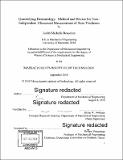Quantifying dermatology : method and device for user-independent ultrasound measurement of skin thickness
Author(s)
Beaudoin, Judith Michelle
DownloadFull printable version (11.28Mb)
Other Contributors
Massachusetts Institute of Technology. Department of Mechanical Engineering.
Advisor
Brian W. Anthony.
Terms of use
Metadata
Show full item recordAbstract
The research summarized here consists of the design of a device and processing technique to acquire and construct 3D volumetric ultrasound data of the hand and arm. The Repeated Skin Thickness Measurement (RSTM) Device moves a high frequency ultrasound probe linearly in 3 axes in a water tank and images a submerged arm. These images are combined into an ultrasound volume, the skin layer segmented, and the thickness extracted. One particular application is measuring progression of scleroderma, a skin thickening disease. Current measurement techniques for scleroderma progression rely on subjective clinical opinion, lack quantitative rigor, are invasive, and often measure parameters besides thickness that are less closely linked to the progression of scleroderma. The current diagnostic process assesses skin thickness based on a single ultrasound image taken by a user holding the ultrasound probe. The imagery that results from the instrumentation and analysis in this thesis is used to create objective maps of skin thickness to quantify the progression of skin-thickening diseases, and can also be used to observe tendons, ligaments, and the other soft tissue structures of the hand. By examining thickness over the surface of the hand and arm, a more robust metric of progression of scleroderma and other soft tissue disease can be attained.
Description
Thesis: S.M., Massachusetts Institute of Technology, Department of Mechanical Engineering, 2018. Cataloged from PDF version of thesis. Includes bibliographical references (pages 86-90).
Date issued
2018Department
Massachusetts Institute of Technology. Department of Mechanical EngineeringPublisher
Massachusetts Institute of Technology
Keywords
Mechanical Engineering.